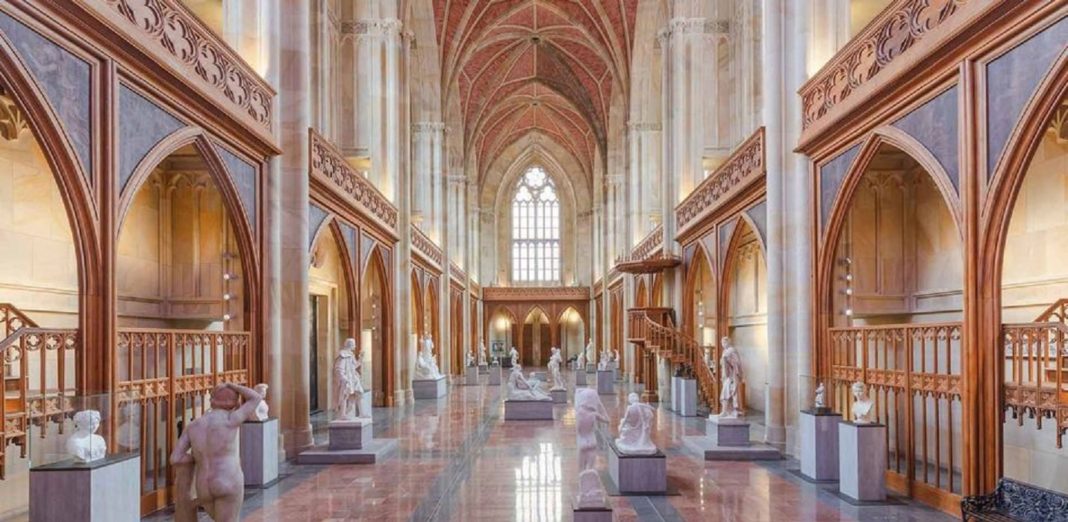The Friedrichswerder Church, planned by Karl Friedrich Schinkel and built between 1824 and 1830, has been a museum church and dependence of the Old National Gallery since 1987. It offers the unique opportunity to experience sculptures of the 19th century in an architecture from that period that has been preserved as far as possible in its original state – and always in a new light. As the most comprehensive collection of 19th century sculptural art, the National Gallery’s sculpture collection occupies an outstanding position within the German museum landscape.
Image above: © Staatliche Museen zu Berlin, Nationalgalerie
Ideal and form
The exhibition “Ideal and Form” traces the lines of development from the long 19th century into modernity with sculptures and sculpture from the Schinkel period to the Empire and invites visitors to rediscover the Berlin school of sculpture, which was already internationally oriented at the time.
With more than fifty sculptures, some of which are larger than life, the exhibition provides a general overview of the Berlin school of sculpture and its international connections. On display are important works by Johann Gottfried and Emil Wolff, Christian Daniel Rauch, as well as works by female sculptors such as Angelica Facius, Elisabet Ney or Anna von Kahle, and works by the Deutschrömer, including unique works by Adolf von Hildebrand or Arthur Volkmann.
Beginnings of the Berlin School of Sculpture – French Influences
In 1747, Frederick the Great was the first Prussian ruler to establish an official court sculptor’s studio, which was to become extremely important for the development of sculpture in Berlin towards a Berlin school of sculpture. Before Johann Gottfried Schadow, three French artists or artists trained in France held the office of court sculptor, including Jean-Pierre Antoine Tassaert, on whose portrait of Mendelssohn his pupil Schadow collaborated. The techniques of marble carving and bronze casting tried out in France were regarded as exemplary and fundamental for the training of his own talents.
Between Antiquity and Modernity – Berlin Sculptors in Rome
According to Johann Joachim Winckelmann, the most important mastermind of classicism, only the personal experience of ancient works of art could complete an artist. Thus Rome became the culmination of an international sculpture scene and a visit to the “eternal city” became an integral part of almost every sculptor’s vita. Some artists, such as Rudolf Schadow, Heinrich Kümmel or Emil Wolff, remained in Italy for almost their entire artistic lives, mediating and restoring antique originals and adapting the normative human design for their own thematic circles that were popular with the public. It was not until the turn of the century that Paris was to become the most important place for training artists.
Successful exports – Berlin in England and the USA
Whereas at the beginning of the century the dignified appearance of antiquity, oriented towards balance and harmony, was the standard for every composition, from the middle of the century onwards budding sculptors in Italy increasingly studied the powerful and dramatically moving works of Michelangelo and Bernini. World exhibitions and competitions with international participation, as well as personal collector interests, promoted the spread of German sculpture in England and America. Casts of celebrated works by the Berlin School of Sculpture such as August Kiss’ “Amazone” or Albert Wolff’s “Lion Fighter” can be found in the USA, as can numerous works by the sculptor Elisabet Ney, who emigrated to Texas.
Erneuerer – Deutsch-Römer zwischen Berlin, Rom und Paris
Around 1890, a generation of sculptors around Adolf von Hildebrand and Artur Volkmann countered the neo-baroque pathos of their teachers with a new approach: No longer were the exaggeration mechanisms of monumental sculpture in the foreground, but increasing concentration and reduction were primary goals. Based on the latest approaches of a scientific psychology of perception, a group of German artists based in Italy developed works of the greatest possible reduction in terms of content and form. Alongside Rome, Paris became a new and highly regarded centre of modern sculpture with Auguste Rodin.
A permanent exhibition of the National Gallery of the National Museums in Berlin. Admission is free.
A comprehensive publication in German and English has been published to accompany the exhibition.
WHEN?
Permanent exhibition
WHERE?
Friedrichswerder Church
Werderscher Markt
10117 Berlin






